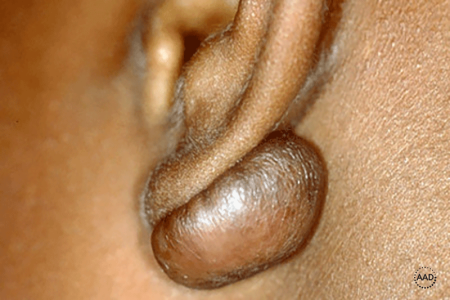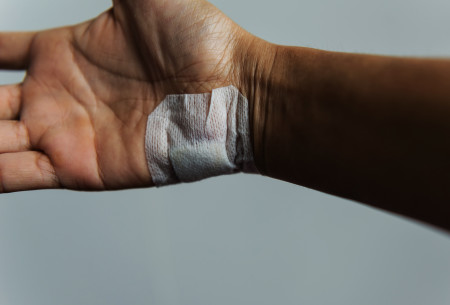Keloid scars: Self-care
Dermatologist tips to prevent keloid scars
Keloids can affect your well-being. Follow these tips from board-certified dermatologists to help prevent keloids from forming.
How to prevent a keloid
If you have keloid-prone skin, you cannot always prevent a keloid. By taking precautions, you may reduce your risk of getting a keloid.
Here are four common causes of keloids and what dermatologists say can prevent (or at least reduce the size of) a keloid.
Piercing: The ear is a common place to get a keloid. If you or blood relatives have had a keloid, you may develop a keloid after piercing any part of your ear. The best way to prevent a keloid is to skip getting a piercing on any part of your ears. Piercings in other areas of your skin can also cause a keloid.
If you still want to try a piercing, here’s what can help reduce your risk of developing a keloid on your ear.
Pay close attention to your ears after getting a new piercing. If you notice the skin on an earlobe start to thicken, you may be able to prevent a keloid if you act quickly. At the first sign of thickening, immediately remove the earring and start wearing a pressure earring instead.This girl developed a keloid after getting her ears pierced
She may have prevented this keloid if she had worn a pressure earring immediately after she noticed her skin start to thicken.

You’ll find pressure earrings available online.
To get the best results from a pressure earring, you must start wearing it as soon as the skin starts to thicken, and you must wear it for at least 12 (and preferably 20) hours a day for 4 to 6 months.
Because you cannot wear another earring under a pressure earring, a new piercing may close. Dermatologists caution against getting your ears pierced again. You may develop another keloid.Tattoo or cosmetic procedure: These all injure the skin, which means you could develop a keloid afterward if you’re prone to getting keloids. The best way to prevent a keloid is to skip the body art and cosmetic procedures.
If you have your heart set on getting one, here’s what can help.
Try a test spot first. To test a tattoo or procedure, start small. For example, if you want a tattoo, start by getting a small tattoo.
If you’re concerned that a cosmetic procedure may cause a keloid, tell your dermatologist or other doctor who will perform the procedure. Your dermatologist may recommend another treatment option or try a test spot.
By starting small, you can watch for thickening skin. This is the first sign of a keloid.
If the skin in the test area starts to thicken, you want to start wearing a pressure garment immediately. Pressure can prevent the thickening skin from turning into a keloid.
To be effective, you need to start with the pressure as soon as you notice thickening skin. A dermatologist can fit you with a pressure garment. Adding another keloid treatment like injections of corticosteroids may also help.Surgery, including dental surgery: A keloid can develop on your skin or inside your mouth. When you need surgery, here’s what can reduce your risk of developing a keloid:
- Tell your surgeon before the surgery that you or a blood relative develop keloids. Your surgeon may be able to take precautions that can reduce your risk of developing a keloid. Having keloid treatment after surgery can also help.
- Pay close attention to the scar left by surgery. If you notice it thickening, contact a dermatologist right away. A dermatologist may be able to prevent the thickening skin from becoming a keloid.
Skin injury: Even a minor wound like a scrape or bug bite can cause a keloid. If you have had a keloid or they run in your family, proper wound care may help prevent a keloid.
Here’s what dermatologists recommend:
Supplies you need
You’ll want to have the following on hand:- Sterile petrolatum gauze or hydrogel wound dressing
- Silicone gel sheets or silicone gel
- Sunscreen with SPF 30 or higher, broad-spectrum protection, and water resistance
If you injure your skin, follow these steps:
- Wash the injured skin immediately with soap and water. Even a minor wound needs this care.
Keeping the wound clean helps to reduce scarring. Using soap and tap water or a saline solution will cleanse the wound without drying it.
Avoid using hydrogen peroxide, rubbing alcohol, or iodine, which can dry the wound. - Bandage the area with hydrogel wound dressing or sterile petrolatum gauze. You want to keep wounds moist. Moisture helps to speed up wound healing.
- Gently cleanse the wound and apply a new wound dressing or gauze every day until the wound heals. When cleansing the wound, you want to avoid scrubbing, which can cause a scar.
- After the wound scabs, apply silicone gel sheets or silicone gel. You can buy both of these products without a prescription. They can help prevent a keloid. To get the best results, you apply a new sheet or gel to the area every day.
You need to wear this every day for about six months. If the wound hasn’t increased in size by this time, you can usually stop wearing the silicone sheets or gel. If you’re unsure when to stop, see a board-certified dermatologist. - Protect the injured area from the sun. After the wound heals, you won’t see a keloid right away. Keloids take time to appear.
The sun's damaging ultraviolet rays can make your scar darker and may slow healing, so it's important to protect the area from the sun. Covering the area with clothing can help. If clothing won’t cover the area when you’re outdoors, use sunscreen.
Protect area from the sun
If you have brown or black skin, dermatologists recommend using a tinted sunscreen. It won’t leave a white residue on your skin.
To get the protection you need, use a sunscreen that offers SPF 30 or higher, broad-spectrum protection, and water resistance.
To be effective, you must apply sunscreen 15 minutes before going outdoors.
If you have a severe injury like a bad burn, seek medical care
This can give you the best outcome.

Partner with a board-certified dermatologist
These doctors are the skin experts. If you are concerned about thickening skin or an existing scar, a dermatologist can create a treatment plan tailored to your needs.
Images
Image 1: Used with permission of the American Academy of Dermatology National Library of Dermatologic Teaching Slides.
Image 2: Getty Images
References
Daggett A, Congcharoen J, et al. “Top 10 things you need to know about keloids and their treatment.” J Miss State Med Assoc. 2016;57(4):108-11.
Kelly AP, Bayat A. “Keloids” In: Kelly AP, Taylor SC, et al. Dermatology for Skin of Color. The McGraw Hill Companies, United States of America, 2016.208-222.
Meaume S, Le Pillouer-Prost A, et al. “Management of scars: Updated practical guidelines and use of silicones.” Eur J Dermatol. 2014;24(4):435-43.
Monstrey S, Middelkoop E, et al. “Updated scar management practical guidelines: Non-invasive and invasive measures.” J Plast Reconstr Aesthet Surg. 2014;67(8):1017-25.
Son D and Harijan A. “Overview of surgical scar prevention and management.” J Korean Med Sci. 2014; 29(6): 751–757.
Tanaydin V, Beugels J, et al. “Efficacy of custom-made pressure clips for ear keloid treatment after surgical excision.” J Plast Reconstr Aesthet Surg. 2016;69(1):115-21.
Vannala V, Mahabob N, et al. “A case of keloid.” J Pharm Bioallied Sci. 2021 Jun;13(Suppl 1):S871-S874.
Written by:
Paula Ludmann, MS
Reviewed by:
Arturo R. Dominguez, MD, FAAD
Ivy Lee, MD, FAAD
Last updated: 12/5/23
 Atopic dermatitis: More FDA-approved treatments
Atopic dermatitis: More FDA-approved treatments
 Biosimilars: 14 FAQs
Biosimilars: 14 FAQs
 How to trim your nails
How to trim your nails
 Relieve uncontrollably itchy skin
Relieve uncontrollably itchy skin
 Fade dark spots
Fade dark spots
 Untreatable razor bumps or acne?
Untreatable razor bumps or acne?
 Tattoo removal
Tattoo removal
 Scar treatment
Scar treatment
 Free materials to help raise skin cancer awareness
Free materials to help raise skin cancer awareness
 Dermatologist-approved lesson plans, activities you can use
Dermatologist-approved lesson plans, activities you can use
 Find a Dermatologist
Find a Dermatologist
 What is a dermatologist?
What is a dermatologist?

